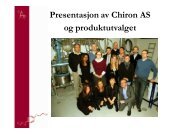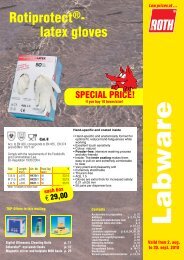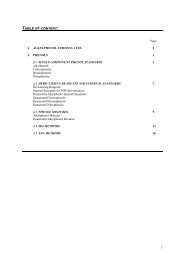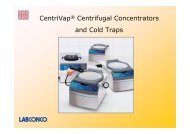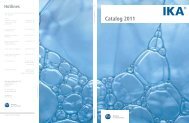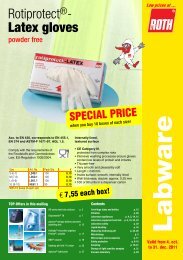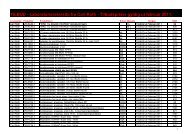Catalog 2010 Technology for Vacuum Systems - Chiron
Catalog 2010 Technology for Vacuum Systems - Chiron
Catalog 2010 Technology for Vacuum Systems - Chiron
You also want an ePaper? Increase the reach of your titles
YUMPU automatically turns print PDFs into web optimized ePapers that Google loves.
Choosing vacuum equipment<br />
Fore-vacuum generation <strong>for</strong> turbo molecular pumps<br />
■ Many analytical applications (such as mass spectrometry, electron microscopy or surface analysis) are carried out in<br />
high vacuum. Turbomolecular pumps are typically used to generate the needed vacuum. Turbo pumps need an auxiliary<br />
backing pump as they cannot compress to atmospheric pressure. Using oil-free diaphragm pumps <strong>for</strong> <strong>for</strong>e-vacuum<br />
generation in connection with state-of-the-art turbomolecular pumps (with "molecular drag" stage) decisively improves<br />
the cleanliness of the vacuum generated. In many cases, such an oil-free high vacuum is absolutely necessary.<br />
Process requirements<br />
■ if the high vacuum system is operated without any gas load, the ultimate vacuum of<br />
the diaphragm pump may be assumed as the backing vacuum. The volume flow rate<br />
of the diaphragm pump then only has an impact on the pump-down time.<br />
■ in case of a noticeable gas load, the backing pump has to be appropriately dimensioned<br />
to guarantee the maximum acceptable backing pressure of the high vacuum<br />
pump. For these applications, it is important to select a diaphragm pump with high<br />
flow rates even near ultimate vacuum. All VACUUBRAND diaphragm pumps are excellent<br />
in this regard due to their planar diaphragm design.<br />
Demands made of the vacuum pump<br />
■ sible backing pressure of the high-vacuum pump; VARIO ® diaphragm pumps offer an<br />
■<br />
■<br />
■<br />
■<br />
■<br />
■<br />
■<br />
■<br />
the required ultimate vacuum of the diaphragm pump depends on the maximum permis-<br />
ultimate vacuum up to 0.3 mbar<br />
high volume flow rate even close to the ultimate vacuum<br />
low energy consumption<br />
low back-streaming leakage rate to prevent venting of the application in the event of power failure<br />
continuous-duty rated, 24/7<br />
not sensitive to condensate<br />
high long-term ultimate vacuum stability and diaphragm lifetime<br />
reliable start-up even under vacuum<br />
small size, low weight and very low vibration<br />
Recommended systems<br />
Typical backing pumps <strong>for</strong> modern wide-range turbo pumps (with molecular drag stage)<br />
down to 4 mbar:<br />
down to 1 mbar:<br />
down to 0.3 mbar:<br />
MZ 2D NT<br />
pg. 92<br />
MD 1 pg. 94 MD 4 NT, MD 4 NT VARIO pg. 96 MD 12 pg. 98<br />
MV 2 NT, MV 2 NT VARIO pg. 100 MV 10, MV 10 VARIO-B pg. 102<br />
Traditional turbomolecular pumps require lower backing pressures. There<strong>for</strong>e, they demand single and two-stage rotary<br />
vane pumps:<br />
Rotary vane pumps<br />
pg. 111<br />
Choosing vacuum equipment<br />
Further in<strong>for</strong>mation at www.vacuubrand.com<br />
23



